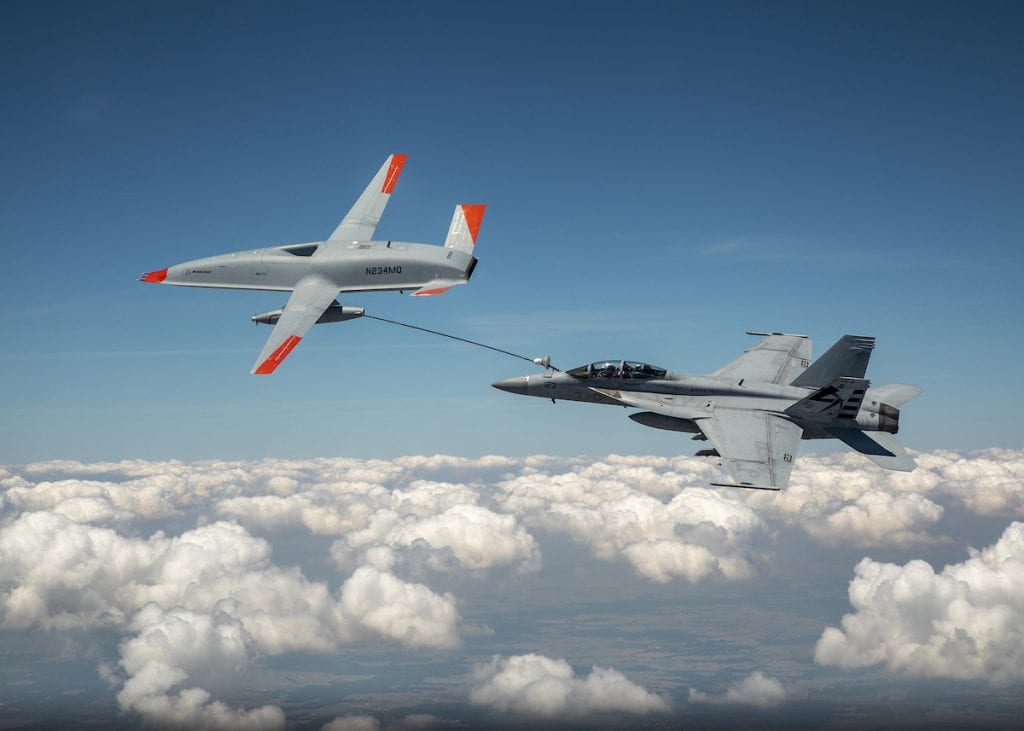
The Boeing MQ-25 T1 test asset transfers fuel to a U.S. Navy F/A-18 Super Hornet on June 4, marking the first time in history that an unmanned aircraft has refueled another aircraft. The MQ-25 Stingray will assume the carrier-based tanking role currently performed by F/A-18s, allowing for better use of the combat strike fighters and helping extend the range of the carrier air wing. (Photo: Kevin Flynn)
In a new demonstration from Boeing testing advanced manned-unmanned teaming (MUM-T) capabilities, the Navy’s MQ-25 Stingray unmanned aerial refueler communicated with other manned aircraft without the need for an air vehicle operator on the ground.
The demonstration occurred in a virtual environment with the MQ-25 communicating with the E-2D Advanced Hawkeye airborne command and control aircraft and the F/A-18 Super Hornet. The Office of Naval Research sponsored the demonstration and Northrop Grumman provided its E-2D simulator to work alongside Boeing’s F/A-18 and MQ-25 simulations.
“Right now, MQ-25, it’s tied to the AVO, the air vehicle operator, almost 24/7,” Don “BD” Gaddis, MQ-25 Advanced Design at Boeing, told reporters on August 3 at the Navy League’s 2021 Sea Air Space expo. “It’s an autonomous vehicle but it flies a mission plan, right? And so if the mission plan has to change, well, then you communicate that change with the air vehicle operator, right. So what happens when those communication links are either degraded, denied, or prohibited by policy?”
MUM-T is “central” to the MQ-25 because of the ranges that the aircraft is going to be flying at, Gaddis said.
Dave Bujold, MQ-25 program director, told reporters that this demonstration is an acknowledgment that it is not acceptable for communications problems to prevent a mission from achieving its goals.
“We want that airplane to be robust and capable when it goes to war,” Bujold said. “So we already know that there will be times that the carrier will decide it wants to shut its radios down and move and our airplane can’t just say I have to go home, that’s not okay. So we know that, the Navy’s told us that, and we’re working on that. The concept of working with the E-2 and working with a striker, like the F-18, cooperatively is building blocks that allow us to say, okay, when that next set of requirements comes down to be more warfighter capable, we’ll have that.”
Boeing used existing Link 16 data to enable communication between the platforms and demonstrated 16 use cases during the exercise. The use cases included the E-2D acting as the air wing tanker king while the MQ-25 refueled the F/A-18.
“What we mean by use cases is, okay, what happens if, in the mission plan, you’re going to take a certain range and a certain orbit from the carrier but because of tactical reasons you have to change the orbit station, right,” Gaddis said. “So how does the manned aircraft communicate that to the unmanned aircraft.”
The use cases tested included the F/A-18 and E-2D changing the tanker’s orbit station, slight path, or aerial refueling store payload.
There was also only minimal changes to the F/A-18 cockpit display and there were no software changes required for the E-2D, Gaddis said, emphasizing that this was true for the tanking mission but might change as other mission scenarios are tested.
“One of the big things is, can we can we put together concepts and appointments with existing data links to meet all these particular objectives and do these use cases, and we found that, much to our surprise, for E-2, there’s not any software changes required for E-2 on some of the early manned unmanned teaming,” Gaddis said. “Now, I have to also emphasize that we’re talking about the tanking mission, right, so that’s our initial mission.”
The autonomy software plays an important role in this kind of teaming because the system not only has to receive the Link 16 message, but then it has to convert the message into autonomy behaviors, Gaddis said.
“The MQ-25 needs to understand that, hey, I’m not on the mission plan right now that I was pre-programmed to do, and, oh, by the way, I’m not talking to the AVO, I am actually talking to an E-2 to an F-18,” Gaddis. “So the MQ-25 has to transition between all those autonomous states and so that’s the software packages that we need to put together.”
While this demonstration used Link 16, Gaddis said they are looking to transition to IP-based data links with a demonstration happening later this year. Boeing will also move these demonstrations to labs in 2022 and hopes to begin flight tests in 2023.
Boeing will also be developing the capability to write the autonomy software and reuse it within other unmanned systems.
“What Boeing needs to do is we need to be able to write the autonomy software and reuse the software for other unmanned systems,” Gaddis said. “A lot of those things that we’re doing can get into crossover into battle management, and a lot of this software can be used for manned aircraft. So the idea of writing the autonomy and being able to reuse it for other manned and other unmanned airplanes, not necessarily in queue, is key to moving forward swiftly with both manned unmanned capabilities.”
Something that Boeing is not trying to do is create a proprietary data link.
“Our objective is not to grow up a new proprietary setting, in fact, it’s the opposite,” Bujold said. “We expected autonomy will work best when we’re not tied to a whole bunch of proprietary setups.”